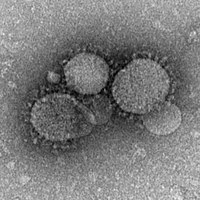
Photo from wikipedia
s / International Journal of Infectious Diseases 79(S1) (2019) 1–150 3 Results: Based on putative coronavirus species classification criteria, the general surveillance effort detected nine coronavirus species, eight alphacoronaviruses and… Click to show full abstract
s / International Journal of Infectious Diseases 79(S1) (2019) 1–150 3 Results: Based on putative coronavirus species classification criteria, the general surveillance effort detected nine coronavirus species, eight alphacoronaviruses and one MERS-related betacoronavirus, from eight different bat species. The species-specific surveillance detected three coronavirus species, including MERS-related betacoronaviruses, and identified several instances of coinfection with two different coronaviruses. The mixed effects logistic regression analyses indicated that female N. capensis bats and bats trapped at low altitude sites with low body condition scores were most likely to be coronavirus positive. Conclusion: This study demonstrates that diverse coronaviruses are present in different South African bat species and lends additional support to an ongoing circulation of MERS-related betacoronaviruses in this region. The observed cases of coinfection indicate the potential for recombination that could lead to the emergence of a new coronavirus that might have zoonotic potential. The collation of ecological data with screening results revealed that both host and environmental factors may influence coronavirus ecology. These findings could assist the development of improved wildlife surveillance sampling strategies for better detection of novel bat coronaviruses. https://doi.org/10.1016/j.ijid.2018.11.026
Journal Title: International Journal of Infectious Diseases
Year Published: 2019
Link to full text (if available)
Share on Social Media: Sign Up to like & get
recommendations!